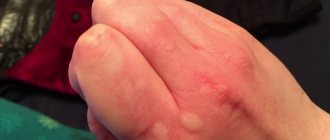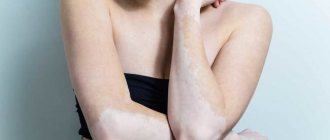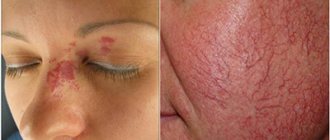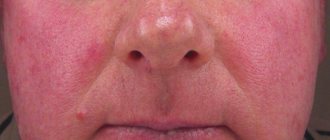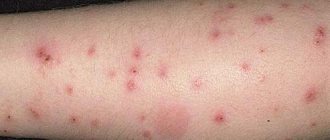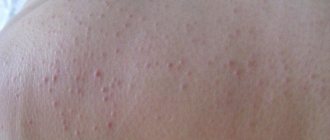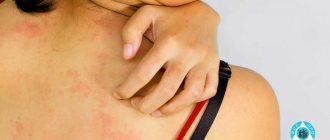Allergies on the feet occur quite often and are characterized by a variety of symptoms: from the appearance of hyperemic spots on the feet and hands to erosive formations.
Allergies on the legs can appear immediately or develop with increasing symptoms. Skin rashes and itching in the toes area usually cause terrible discomfort, leading to limited mobility. Therefore, this disease must be taken seriously and treatment must be started at the first sign of an allergy.
Development of allergies in the legs
Allergies can be dangerous, uncomfortable and irritating
Allergies occur in children and adults. It can be dangerous and cause discomfort and itching. When an allergy develops quickly in a leg, it results in the ability for a person to walk slowly or become incapacitated to the point where they are unable to walk.
It is important to prevent the problem from developing; you need to take it seriously. There are different causes of allergies and they can develop in both the feet and legs.
Toes are susceptible to allergic reactions. The nature of the impact is caused by internal irritants that enter the immune system and body. Skin allergies are also caused by external irritants. The stain may appear as a result of human contact with fluff, animals, wool, and dander from other organisms.
Red spots are the result of disorders of the endocrine or nervous system. If the function of the adrenal glands decreases, a rash cannot be avoided.
What is the cause of the disease?
The reason lies in one or another allergen, which irritates the skin, can penetrate deep into the epidermis and become a real disaster for the patient himself and his loved ones, especially for children.
First of all, fungal diseases, as well as disorders associated with the circulatory system, should not be classified as this disease. Although, the symptoms may be similar: there is also redness on the skin and itching.
Among the most common reasons why allergies appear in childhood is intolerance to certain foods. You can often see a rash on your baby's legs after drinking milk. A similar reaction is most often visible on the legs during the period when complementary feeding begins, when the mother gradually begins to give the child liquid porridge based on cow's milk. In order for the problem of foot allergy to develop into a persistent diathesis, you should stop giving the product and do special tests, after which it will be possible to adjust the diet. Often mothers dilute whole cow's milk or replace it with goat's milk.
The main allergy-provoking factors are:
- dust contained in carpets, furs, bed linen or in the structures of upholstered furniture. Dust mites are becoming the main causative agents of allergy attacks in adults and children. To prevent such phenomena, you should clean your apartment more often, at least once a week: wet treat all surfaces, wash curtains and carpets, clean soft surfaces of furniture using special products, and also ventilate the room as often as possible;
- Animals very often become the cause of allergic diseases. If an adult develops an allergy to their feet, they should limit contact with pets. A special point should be made about the rules of conduct for women carrying a child. You should be careful not only with pet fur, but also with aquarium fish food, since even such harmless creatures can cause severe attacks. Insect bites also belong to this group;
- chemical materials. Allergies on the feet of an adult can occur due to wearing synthetic materials from which socks, tights, and shoes are made. Material and dyes are potential allergens, since the body’s reaction and its severity depend on production technology, chemicals, and processing of materials;
- plant crops, house plants or fluff from flowering trees and bushes growing outdoors, all these external factors are a potential threat to people suffering from chronic allergies;
- The fungus can cause an allergic rash and peeling on the skin of the feet and toes. In this case, complex treatment is used using antihistamine drugs and antifungal drugs.
What causes foot allergies?
Rubbing the skin when walking in uncomfortable shoes can cause foot allergies.
Allergies on the feet can be caused by shoes that press or rub the skin, then an allergic reaction will begin to develop. If the shoes are of poor quality and contain chemicals, irritation and itching will occur.
An example would be products: sandals, slippers, which contain dyes. Your legs will swell faster in this mode, and allergens will make themselves felt.
Foods can cause unpleasant reactions. The main allergic components that are found in foods: honey, seafood, citrus fruits, sweets, nuts, and foods with protein.
Cold is a strong skin irritant. Some people cannot tolerate temperature conditions; hypothermia or hot climate conditions create discomfort in the body and cause negative reactions in the body. Spots appear on the limbs, which can actively develop. To prevent this, you should not allow your body to freeze, you should not come into contact with ice water, and you should be careful when eating cold food.
Substances that actively cause reactions: dust, cosmetics, medications, sun. If a person uses drugs that create an active effect on the human body, he needs to stop taking them and find substitutes.
In order not to develop problems in the endocrine system during an allergic reaction, it is not allowed to stay in the sun for a long time.
Cosmetic preparations cause the development of allergies. Depilatory creams can cause terrible irritation, and scrubs are not always compatible with the characteristics of the skin.
To prevent allergic rashes on the legs, it is recommended:
- Wash your feet in cool water using gentle detergents;
- After any water procedures, thoroughly wipe the space between the toes - this will prevent the occurrence of foot fungus;
- Wear shoes and clothes made from natural materials;
- Use an ointment or cream with an anti-inflammatory effect prescribed by a dermatologist;
- Apply a moisturizing cream to your feet, such as La Cree healing cream. It will not only relieve inflammation, itching, speed up the regeneration process if rashes have already appeared, but will also prevent their occurrence. The cream perfectly moisturizes the skin without leaving an unpleasant sticky film on the body. Thanks to natural ingredients and the absence of hormonal elements in the composition, La-Cri cosmetics are recommended even for children. The cream is sold only in pharmacies and meets international quality standards.
What are the symptoms of allergies?
Skin allergies cause redness
Allergies can affect the entire human body. The feet, hips, and legs are often affected. The manifestation of allergies goes away quickly. Within a couple of hours, you can see spots on the limbs and body after contact with a person who is sick.
What are the signs that affect the functioning of the immune system?
- allergic areas on the body begin to peel off;
- the skin begins to turn red under the influence of allergic contact;
- active dryness on the body (this place is the site of an allergic reaction).
Consumer Reviews
Nastena (vseotzyvy.ru)
“My son is now one year and seven months old. Until this time there were no health problems, just little things. But when he started eating everything, he began to develop a rash on his cheeks, terribly rough skin, and something else. We recently changed his diaper panties, and suddenly the folds of his groin began to become covered with a terrible redness. The poor thing scratches and scratches. Powder, starch, creams did not help. I took her to the doctor, she prescribed me to buy diaper cream from La-Cri and apply it after every pee or diaper. That's how I started treating him. Judging by the packaging, its advantages are as follows: non-hormonal composition, it contains zinc oxide and panthenol, and due to oils it softens and nourishes the skin, it is allowed from the first days of life. As I later understood, it works like this: after applying a small amount of the product, a kind of protective film is created on the skin, which protects the skin from getting wet and damp. And ttt, healing is going much faster than I expected. Just a little more time and everything will finally pass. I advise all parents not to experiment with hygiene products, and to take only proven and safe products.”
Agnia (vseotzyvy.ru)
“My hands get very dry in winter: whether you wear gloves or not. Everything tightens so disgustingly, and the cuticle looks very sloppy. I apply the cream several times a day. I've been using it quite often lately - every time after washing my hands. The other day I ran out of mine, and I ran to the pharmacy to buy something new and grabbed La Cree for dry skin. Girls, this is a magical thing!! Now I apply it at night and in the morning - it lasts for the whole day. My hands are velvety, everyone asks what I use. And this is my small discovery. So I recommend it to everyone)).”
Sources:
- Fokina R.A., Atopic dermatitis: stages of development of classification forms, Siberian Medical Journal, 2007 https://cyberleninka.ru/article/v/atopicheskiy-dermatit-etapy-razvitiya-klassifikatsionnyh-form
- A.N. Pampura, A.A. Chuslyaeva, Modern approaches to the treatment of atopic dermatitis in children https://cyberleninka.ru/article/v/sovremennye-podhody-k-terapii-atopicheskogo-dermatita-u-detey
- Yukhtina N.V., Modern ideas about atopic dermatitis in children https://cyberleninka.ru/article/v/sovremennye-predstavleniya-ob-atopicheskom-dermatite-u-detey
Types of allergies
The most common types of allergies on the legs are spot, diffuse and raised
There are different types of spots. There are dotted, diffuse, and towering ones. They have their own color and vary in different shades. You need to carefully apply the medications to the outer part of the skin, and also take medications that eliminate allergic spots.
How to deal with allergic acne?
Acne comes in different forms and is an allergic disease. They appear on the body with protuberances of different sizes and shapes; they are red and dark blue. Sometimes they can be black, but mostly they are purulent pimples.
In place of acne, purulent foci form, which become covered with crusts. To eliminate the allergic function, you need to take a course of medications prescribed by an allergist, because the main problem is in the endocrine system.
Allergic acne can be eliminated; cosmetologists can provide all the necessary assistance with this.
What should you know about edema?
Edema is an active external object that shows that not everything is correct with your body part and body. Swelling occurs when allergens actively affect the body.
In this case, the accumulation of fluid in the subcutaneous tissue is the main element that has a positive effect. The positive character lies in the fact that the reaction appears outside and makes itself felt.
What should you know about itching?
Itching is a syndrome that causes the desire to scratch one's body or limbs. It is difficult to refrain from this, and therefore creams that relieve allergic itching come to the rescue.
Itching may occur before the rash appears. It can be acute, chronic, local, generalized. For itching, it is recommended to use medications that complicate the penetration of excess organisms and infections inside.
Treatment of foot fungus
To be successful in treating dermatitis caused by an allergic reaction to shoes, it is necessary to avoid contact with the allergen. During the examination, as a rule, it is possible to identify the substance that causes such a reaction. If it is leather, then you will have to replace leather shoes with models made from textiles. You can limit skin contact with shoes by wearing socks.
For the treatment of allergic dermatitis, it is recommended to use antihistamines. These remedies will help relieve itching and swelling. These could be drugs such as Cetrin, Zodak, Erius, etc. You will need to take 1 tablet per day for at least 10 days in a row.
Locally, lotions with Burov's liquid can be applied to the area of the affected skin of the feet. For your information, this liquid is also very helpful in treating dry eczema and otitis externa.
Ointments containing corticosteroids may be prescribed. Such ointments are prescribed in short courses - with 1-2 times a day for no more than 15 days.
For the treatment of contact dermatitis, it is recommended to choose the latest generation of ointments that do not contain fluoride. These can be drugs such as Lokoid, Advantan, Elokom, etc.
In the acute phase of dermatitis, injections of drugs that have a desensitizing effect, for example, calcium gluconate, can be prescribed. If the skin is severely dry, it is recommended to apply a thin layer of boric Vaseline on the feet 2-3 times a day.
If the lesions are very severe, systemic corticosteroids may be prescribed to treat contact dermatitis. These drugs can give unwanted side effects, so the duration of the course and dose must be selected individually for each patient.
In addition, patients with contact dermatitis are recommended to adhere to a hypoallergenic diet. To wash your feet, you should use only neutral products, such as baby soap. If your skin gets too dry after washing, you can lubricate it with baby oil.
Treatment with traditional methods
Methods recommended by traditional healers can also help in treating dermatitis caused by an allergic reaction to shoes.
But before using this or that recipe, you should make sure that the components used do not cause allergies. For example, recipes often use beekeeping products (honey, propolis, etc.), which themselves can provoke an allergic reaction, which will worsen the patient’s condition.
Foot baths with the addition of medicinal herbs will help soothe irritated skin. To prepare baths, you can use oak bark, string grass, hop cones, and burdock roots.
To make compresses for contact dermatitis, you can also use a collection of herbs. You need to take chamomile, sage, valerian root, celandine herb and St. John's wort in equal quantities. Take 150 grams of grass and pour boiling water so that the water only slightly covers the grass. Leave for half an hour. Then place the steamed herb on gauze and apply it warm to the affected skin of the feet.
Sea buckthorn oil can be used to treat erosions due to contact dermatitis.
Pumpkin helps well in healing irritated skin with allergic dermatitis. You can use the grated pulp for compresses, or squeeze the juice out of the pumpkin and use it as a lotion on inflamed skin.
An effective remedy for relieving the symptoms of contact dermatitis is propolis oil. To prepare it, you need to combine crushed propolis (1 part) and any vegetable oil (4 parts).
Heat in a stove or oven until the propolis dissolves, about 50-60 minutes. Then pour into a glass jar.
Apply oil for compresses on skin affected by dermatitis. The recipe can be used provided there is no allergy to propolis.
At the first signs and symptoms of mycosis of any kind, you need to visit a dermatologist.
For treatment to be effective, it is important to promptly contact a qualified specialist who will correctly determine the type of fungus that has affected the foot. It depends on the type of pathogenic fungus how to treat it.
The doctor must prescribe a comprehensive treatment, which includes several drugs for skin fungus. The complex should include the following drugs:
- external remedies for fungus (antimycotic ointments, creams, varnishes, etc.);
- antifungal drugs for skin fungus;
- antihistamines to relieve itching;
- vitamin and mineral preparations to improve immunity;
- antibacterial agents (only in the presence of an infection of bacterial origin).
If the form of fungus on the skin is not very advanced, then the doctor may prescribe external broad-spectrum antimycotics. Such drugs affect various etiologies of mycosis and reduce the likelihood of relapse. Good treatment results are obtained from the antifungal remedy Lamisil, which has been effectively used for more than ten years.
If the lesion is localized between the fingers, anti-fungal ointment is applied to cleansed skin once a day. Treatment lasts for 7-10 days and ends when the symptoms of mycosis completely disappear.
In case of damage to the skin of the foot, a therapeutic pedicure is first performed in order to remove the keratinized epidermis. Hardware pedicure can be done by specialists or yourself at home.
In the latter case, it is necessary to use salicylic compresses and wraps. To do this, you need to make a foot bath with soda and soap.
You need to remove the stratum corneum from the steamed skin and trim the affected nails. At the same time, it is important to dispose of scraped scales and trimmed nails, and also treat the instrument after use, since fungus spreads through all this.
Weeping mycosis can be lubricated with brilliant green, a solution of boric acid, or medical blue. For advanced forms, corticosteroids are used against fungus.
The following drugs can be prescribed for the treatment of fungal diseases: “Clotrimazole”, “Miconazole”, “Pimafukort”, “Mifungar”, “Fungicide”, “Triderm”, “Candid-B”, “Exoderil”, “Daktarin”, “ Kanesten."
Before applying one or another antifungal remedy to the affected area, it is necessary to relieve the inflammatory process and remove keratinization. After applying foam, gel, spray or ointment against fungus, you do not need to wash your feet for the next 24 hours so as not to wash off the protective layer created by the drug.
Timely treatment of skin fungus on the toes and nails is more effective and costs the patient much less than treating its relapses.
Allergy treatment methods
Provided that you start taking medications in time that reduce the manifestation of allergies, the disease will not begin to develop vigorously
Treatment for allergies on the feet is similar to treatment for other areas of the skin. If you start taking medications in time to reduce allergy symptoms, the disease will not actively develop.
Groups of drugs are divided and depend on the symptoms and form of allergy in the legs. Please note the following:
- antihistamines;
- local ointments;
- hypoallergenic diet;
- hormonal background.
The treatment is long-term and extensive, so the allergy does not go away in one day, if the reaction does not appear after taking the pills, they do not need to be stopped if your doctor prescribed them.
Take medications according to the schedule prescribed by your doctor. Focus on what you eat, what clothes you wear, what places you go.
Allergies in pregnant women
During pregnancy, patients experience hormonal changes in the body, when allergies are possible even to quite familiar substances. This reaction is quite natural.
Allergies on the legs, and in some cases also the arms, during pregnancy most often occur between the second and third semester, when changes in the skin occur. Particularly dangerous moments are when rashes, pimples and blisters itch and burst, and subsequently become infected.
If an allergic reaction during pregnancy appears only on the feet, it is necessary to exclude mycotic diseases.
Since the risk of swelling increases during pregnancy, especially in the arms and legs, you should regularly examine the color of the spot and how densely the rash is spread. When determining the causes of allergic symptoms on the arms and legs during pregnancy, drug therapy should be carried out.
How to treat red spots due to allergies
As mentioned earlier, the most important thing is to eliminate the source of the allergy. Sometimes this is enough to prevent its development. Wash off any cosmetics that cause irritation, eliminate allergen products from your diet, and wash your hands thoroughly after using household chemicals.
If you cannot find the cause of the red spots on your own and their appearance is accompanied by other unpleasant symptoms, consult a doctor. Just a few laboratory tests will reveal what exactly you are allergic to, or diagnose that the nature of the skin irritation is not allergic in nature.
The doctor will prescribe antihistamines for oral administration and special ointments that relieve symptoms. In advanced cases of allergies, corticosteroids may be required.
Susceptibility to certain allergens may increase depending on the general condition of the body: illness, stress. So, to eliminate red allergic spots, you need to follow a healthy lifestyle. You may need to adjust your diet and regimen. Give up bad habits, try to spend more time outdoors. But do not forget to wear gloves in cold weather or use sunscreen in summer, otherwise you may develop an allergy to the cold and sun.
During treatment, limit visits to baths and saunas so that irritated skin is not subjected to even greater stress. Try not to abuse alcohol - sometimes allergies in the form of red spots occur to it.
You can relieve such unpleasant symptoms that accompany the appearance of skin irritation, such as itching and peeling, using folk remedies. A decoction of oak bark, birch leaves, and herbal tinctures are effective - they should be used to wipe red spots that itch in case of allergies.
Irritated skin requires special delicate care. During treatment, give up regular cosmetics (who knows, maybe it’s what caused the allergy) and use special products to cleanse the skin.
The La-Cri series helps well against red spots due to allergies. The La-Cri cosmetic complex helps with skin allergies, helping children and adults equally gently and effectively. Cleansing gel provides delicate hygiene for both dry and wet stains. A light cream relieves redness, itching and flaking, promoting skin restoration. Due to the absence of dyes and fragrances, La-Cri products are non-addictive and suitable for long-term use.
Pathological causes
Spots on the legs can appear for many reasons. By its appearance and accompanying symptoms, you can understand what caused the rash and how to treat it. Often the causes of the appearance of red dots are various diseases. [ads1]
Allergy
Allergies are one of the most common causes of spots on the legs and entire body. She may be:
- Food. This allergic reaction is associated with the consumption of allergenic foods. This could be nuts, honey, citrus fruits, dairy products, sweets, etc.
- Medication. An allergy to medications can be caused by the body's hypersensitivity to individual components of the drug, as well as by improper use or overdose. Most often, unpleasant symptoms, including the appearance of red spots on the legs, are associated with taking antibiotics, but other types of medications can also provoke a negative reaction.
- Contact. An allergic reaction is triggered by contact with an allergenic substance. These include cosmetics, unsuitable hygiene products, and contact with plant juice or pollen on the surface of the skin.
The most common types of allergies that cause red spots on the legs are atopic and contact dermatitis.
Eczema
Eczema is a skin disease in which red spots of varying sizes appear on the skin of the legs or other parts of the body. They are often dry, itchy, covered with a crust that flakes off. But sometimes ulcerations appear on the surface of the rash. In this case, the disease is called weeping eczema. [ads2]
The disease can develop against the background of frequent allergic reactions, as well as numerous pathologies of internal organs. The risk group includes diabetics, patients with weak immunity and HIV infection.
Psoriasis
Psoriasis develops when the body begins to actively produce skin cells, as a result of which there are more of them than necessary. The development of the disease can be the result of severe stress, injury, infectious diseases, taking certain types of medications, or bad habits. [ads3]
Psoriasis is an immune disease, the development of which is difficult to predict and prevent. Moreover, it cannot be completely cured - you can only relieve the symptoms and put the pathology into remission.
Folliculitis
Inflammation of the hair follicles is most often observed on the lower extremities. [ads4]
The disease affects mainly women, although it can also develop in men (in this case, not only on the legs). The main cause of folliculitis is mechanical damage to the skin. For example, while shaving.
Fungal infection
The fungus most often affects the toes, but can also develop on the feet and legs. The disease is very contagious and is easily transmitted through personal contact. Also, mycosis of the skin of the legs can develop after undergoing a course of treatment with powerful antibacterial drugs. [ads5]
Fungus of the lower extremities is a common occurrence in people with excessive sweating of the feet. Wearing underwear made from synthetic materials can also cause this disease. The skin becomes irritated under the influence of unnatural components, microcracks can form on it, through which fungi can penetrate into its thickness.
Lichen
Lichen planus is another cause of spots on the legs. The disease is not transmitted by contact, so it is not dangerous to others. According to experts, the development of LP is associated with genetic conditioning. The pathology is accompanied by severe itching, peeling, and burning. At the same time, it is accompanied by psychological discomfort that the patient experiences during the next attack of unpleasant symptoms. [ads6]
This type of lichen can be determined at home. To do this, the red plaque must be lubricated with any vegetable oil and wait for the result. It won't take long to notice: white dots and/or lines will appear on the surface of the rash.
It is impossible to completely cure this pathology. But if you seek help from a doctor and undergo a course of symptomatic therapy, the disease may not bother the patient for a long time.
Blood vessel diseases
Red spots on the legs that itch and cause discomfort can appear not only due to the development of skin pathologies. Many disorders of the internal organs can also lead to the formation of such a rash. In particular, these may be diseases of the blood vessels:
- thrombosis;
- vasculitis;
- phlebeurysm;
- venous hyperemia.
With the above pathologies, spider veins or large red spots may appear on the surface of the skin. As the disease progresses, the skin rashes on your legs will begin to itch.
The appearance of itching is a very alarming symptom that you should not turn a blind eye to. He speaks of a serious circulatory disorder and the development of complications of the disease.
Erysipelas
Erysipelas, or erysipelas, is an infectious skin disease caused by streptococci. With this pathology, a spot forms on the leg - large or small - with an intense, bright red tint. It itches a lot and causes discomfort – physical and psychological.
Erysipelas is accompanied by other symptoms, the most common of which are hyperthermia and general malaise. An existing spot can grow over time, covering healthy areas of the skin. Along with the defect, discomfort also grows.
The cause of streptococcal infection can be injury: a scratch, wound, microcrack, cut. In some cases, even a violation of the integrity of the skin under the nail plate on the toe can contribute to the development of erysipelas of the skin.
Allergy to the sun
Allergy to the sun is one of the types of dermatitis - photodermatitis (or photodermatosis). In this case, red spots appear on the legs, as well as on other parts of the body, including the face. They are very itchy, painful and cause physical and psychological discomfort.
Symptoms of photodermatitis can develop immediately or after some time after exposure to the sun. The process of disease development takes from several hours to 1-2 weeks. The cause of unpleasant symptoms may be:
- some types of medications (hormones, antibiotics, NSAIDs, etc.);
- Food;
- cosmetics (creams, perfumes, etc.).
There are categories of the above mentioned products that increase the body's photosensitivity. Therefore, you should avoid using or consuming them before going out into the sun.
Diabetes
The formation of red spots on the skin of the lower extremities is a common occurrence in diabetes mellitus. The spots are itchy and may also be weeping. Due to poor circulation in the legs, spotted growths may have a red-violet hue. In some patients they are accompanied by pain.
Severe itching forces the patient to frequently scratch the rash. This leads to injuries, wounds and ulcers. These lesions can then become infected by a bacterial or fungal infection, significantly worsening diabetes.
Scabies
Scabies is a parasitic skin disease caused by the scabies mite. It has the ability to penetrate into the thickness of the skin, leaving behind a barely noticeable furrow. If indeed the cause of itching on the legs lies in this disease, then the red spots will look like small, numerous dots. After scratching, they may turn white and pink.
Helminthiasis
Helminths are parasites whose waste products cause increased sensitization in the human body. The consequence of this is a small spotty rash on the body or in certain areas, for example, on the legs.
Liver and kidney diseases
With liver and kidney diseases, toxins accumulate in the body. They are not completely eliminated from it, but circulate in the blood and enter the internal organs. The skin is one of the first to suffer from such disorders.
Red dots form on it, which can be located on any part of the body, including the lower limbs. The spots are very itchy and may peel off. At the same time, depending on the affected organ (liver or kidneys), other unpleasant symptoms of the pathological process appear.
